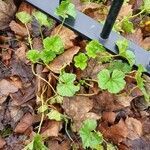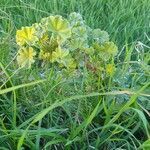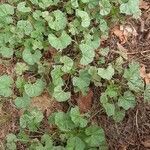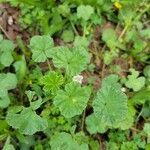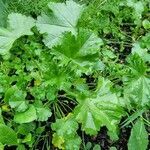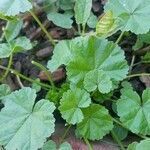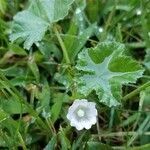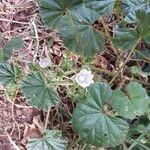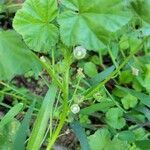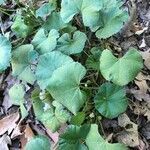Herbs perennial, usually procumbent, many branched, 20-50 cm tall, scabrous. Stipule small, ovate-lanceolate, 4-6 × 2-3 mm; petiole 3-12 cm, stellate velutinous; leaf blade reniform, rarely 5-7-lobed, 1-3 × 1-4 cm, papery, abaxially sparsely stellate puberulent, adaxially sparsely velutinous, base cordate, margin minutely denticulate, apex rounded. Flowers usually 3-4-fascicled, axillary, rarely solitary on stem. Pedicel 2-5 cm, sparsely stellate puberulent. Epicalyx lobes lanceolate, 2-5 × 1-1.5 mm, stellate puberulent. Calyx campanulate, 5-6 mm, stellate puberulent, 5-lobed, lobes triangularly acuminate. Corolla white to pinkish, 10-12 mm in diam.; petals obcordate, 9-15 × 3-5 mm, apex notched; claw bearded. Filament tube stellate puberulent. Style branches 13-15. Fruit flat globose, 5-6 mm in diam.; mericarps 12-15, abaxially smooth, angles rounded, puberulent. Seeds reniform, ca. 1 mm in diam., reticulate or not. Fl. summer.
Annual, occasionally perennial herb, stems ± 0.25 m long; taproots deep, strong. Leaves relatively small, reniform, undivided to shallowly lobed. Flowers axillary, solitary or in few-flowered clusters, white. Epicalyx of 3 free, linear-lanceolate bracts. Flowering time Oct.-Feb. Fruit flattened, discoid schizocarps, surrounded by enlarged calyces. Mericarps 9 or 10, 1-seeded, glabrous, rugose; edges of mature mericarps slightly raised but neither toothed nor overlapping adjoining mericarps. Seeds reniform, dark brown, minutely tuberculate.
Herb, up to 200 mm tall. Leaves undivided to very shallowly lobed. Epicalyx bracts much narrower than sepals. Petals shorter than 15 mm, usually not more than twice as long as calyx. Mericarps 9-16, distinctly reticulately ridged on back, glabrous, edges often slightly raised but neither toothed nor overlapping adjoining mericarps. Flowers white or pale mauve.
A herb. It can grow each year from seeds or keep growing for 2 years. It has long tough taproots. The stems can be 50 cm long. The leaves are alternate along the stem. They are an oval shaped and have teeth along the edge. The flowers have 5 petals and are white or pink. There are 8-10 seeds for each flower.
Annual, occasionally perennial herb. Stems decumbent, up to 0.5 m long. Leaves undivided to very shallowly lobed, ± 20 x 25 mm. Flowers: petals < 15 mm long, usually not > twice as long as calyx. Fruit with mericarps usually glabrous.
